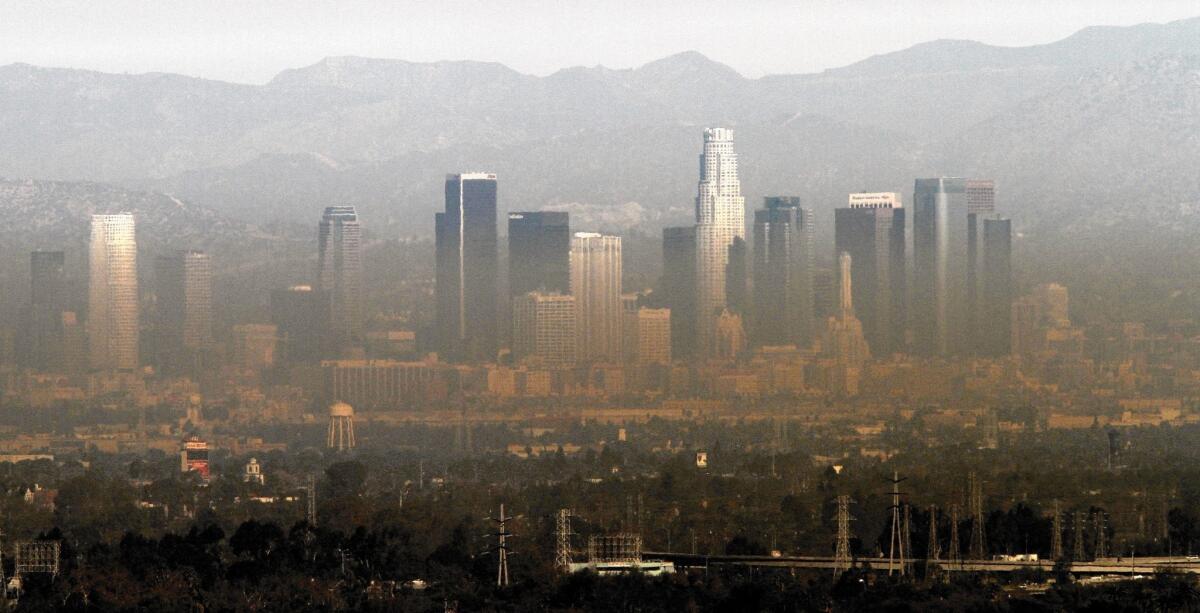California’s powerful and influential air pollution watchdog

On the outskirts of Los Angeles, in a nondescript laboratory, a man in a yellow T-shirt and helmet sits on a stationary motorcycle, looking intently ahead. The bike’s back wheel is spinning and a long orange tube connects to its exhaust pipe. A fan roars, mimicking wind.
Nearby, on a computer screen, colorful lines show the concentration of pollutants emitted from the motorcycle, such as nitrogen oxides and carbon dioxide. This is an emissions test, and the rider must calibrate his acceleration and deceleration precisely, even as he goes nowhere.
“It’s like 55 things you’ve got to do to get this test right,” said Tom Valencia, a branch chief for the California Air Resources Board, the state agency that runs the lab, as the next test, on a Chevy Impala, got underway.
The Air Resources Board, one of the most influential — and controversial — pollution regulatory agencies in the nation, conducts more than 1,500 tests each year at the lab.
To environmentalists, the board offers a bulwark against pollution, setting an example for the nation and the world on how to clean the air and fight climate change. To detractors, it is an out-of-control agency run by unelected bureaucrats who are throttling the state economy.
“It’s come to the point that they tell you what to do, and you salute. And you hope that your members don’t fire you,” said Jay McKeeman, a vice president at the California Independent Oil Marketers Assn.
Besides its long-standing mission to scrub California’s air of damaging pollutants, the board in recent years has taken charge of the state’s efforts to combat climate change, including the controversial cap-and-trade system that limits greenhouse gas emissions across most of the economy.
“It’s not hyperbole when I say there is probably not a more important agency, not just in this country but around the world, than CARB and what they’re doing on pollution control and climate change,” said William Becker, executive director of the National Assn. of Clean Air Agencies in Washington.
The air board’s roots go back nearly half a century to a time when thick smog smothered Southern California. Air pollution was a menace, in the words of Gov. Pat Brown, the current governor’s father. A Dutch-born biochemist at Caltech, Arie Jan Haagen-Smit, took up the challenge.
After studying plants’ reactions to different compounds and collecting flasks of dirty air, he ultimately traced the smog to a reaction involving vehicle exhaust and sunlight, as well as emissions from industrial plants. Oil companies and automakers fought his conclusions, but in 1968, Gov. Ronald Reagan appointed the “stubborn Dutchman” chair of the brand-new Air Resources Board. Haagen-Smit, a lifelong smoker, died of lung cancer in 1977.
His name is on the Los Angeles-area lab, which plans to test so many vehicles, including heavy-duty trucks and cars using new technologies, officials want to move it to a bigger space. The tests cover everything from tailpipe emissions to vapors given off during refueling. The air board certifies new vehicles sold in California, an unusual role for a state-level agency.
Adrienne Alvord, the California and Western states director for the Union of Concerned Scientists, said the air board’s policies were paying off.
“They have not been afraid to stand up to oil companies and auto companies, which are obviously very well-heeled interests, in the interest of achieving clean air for the public good,” she said.
Air quality has greatly improved since the board began its work, though ozone and fine-particle pollution still plague parts of the state. But the war on smog helps explain why the agency became so powerful. When Congress passed the Clean Air Act decades ago, it allowed California to set its own standards, more stringent than the federal government’s, for pollution from cars.
Mary Nichols, 70, is at the helm of the air board. She is a veteran regulator and environmentalist and served as the board’s chairwoman more than three decades ago, when Jerry Brown was governor the first time. In 2007, Gov. Arnold Schwarzenegger appointed her chair again.
The agency, which is part of the California Environmental Protection Agency, is approaching 1,400 employees and has a budget of more than $730 million, larger than most states’ environmental agencies.
“Certainly when I first started at the Air Resources Board in 1975, we didn’t see energy efficiency or fuel use as being part of our mandate,” Nichols said in a recent interview. “It simply wasn’t something we paid a lot of attention to.”
But since Assembly Bill 32, California’s landmark climate change law, passed in 2006, “thinking about climate change has become a part of everything we do,” she said. For Nichols, that has meant a steady stream of international visitors and trips. She spoke at an international climate change summit in Peru in December and visited China for the launch of an emissions trading system there.
“I think the thing that’s probably surprised me the most is the international role that we play today,” she said.
As Brown and lawmakers strengthen their climate goals, the air board remains a lightning rod. About a decade ago, the Legislature debated whether the board or an interagency group should take charge of climate programs, such as cap-and-trade. The air board won, and now industry groups shudder at the idea of the agency expanding its role and crafting new programs.
“The level of authority granted to ARB … is quite dramatic,” said Michael Shaw, a vice president with the California Manufacturers and Technology Assn., in testimony in July over a bill that would require the air board to carry out a plan for cutting petroleum use in half by 2030. “Taking it further, we think, is a tremendous error.”
That’s not how Nichols sees it.
If lawmakers craft new climate and pollution goals, she said, the air board will engage in a long process of consultation on how to achieve the new standards, as happened with earlier climate programs.
“The science behind global warming requires that more stringent targets be met,” she said. “And California’s goal of being a leader in this field, which we believe benefits our economy overall, requires that we stay ahead of the pack.”
Kate Galbraith is a writer for CALmatters, a nonprofit journalism venture dedicated to explaining California policies and politics. For more on its series on California climate change, click here.
More to Read
Sign up for Essential California
The most important California stories and recommendations in your inbox every morning.
You may occasionally receive promotional content from the Los Angeles Times.










